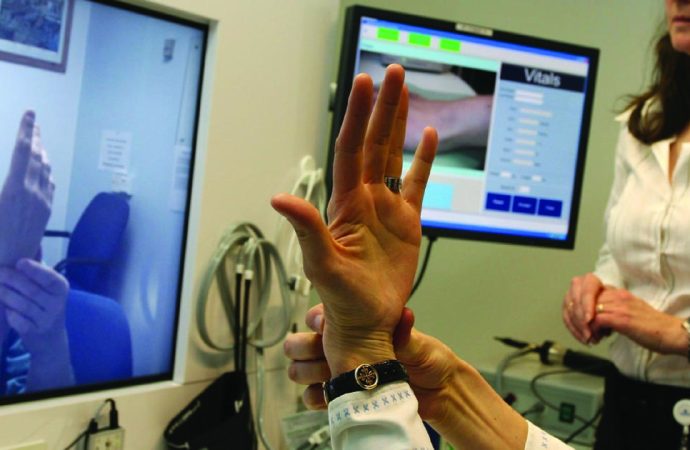Telehealth Post-Pandemic Growth The expansion of telehealth services has significantly increased accessibility to healthcare, especially in the post-pandemic era. Telehealth has broken down geographical barriers, allowing patients in remote or underserved areas to access medical consultations, follow-ups, and specialist advice without the need to travel long distances. This increased accessibility has been particularly beneficial for
Telehealth Post-Pandemic Growth

Image by : Yandex
The expansion of telehealth services has significantly increased accessibility to healthcare, especially in the post-pandemic era. Telehealth has broken down geographical barriers, allowing patients in remote or underserved areas to access medical consultations, follow-ups, and specialist advice without the need to travel long distances. This increased accessibility has been particularly beneficial for individuals with chronic conditions, the elderly, and those with mobility issues, ensuring they receive timely medical attention and continuous care. Moreover, telehealth has facilitated better patient monitoring and follow-up. Healthcare providers can now keep track of their patients’ health metrics through remote monitoring tools and virtual check-ins, ensuring that any potential issues are identified and addressed promptly. This continuous monitoring has led to improved patient outcomes and reduced hospital readmissions, as patients receive more proactive and personalized care.
Integration with Traditional Healthcare
Telehealth has seamlessly integrated with traditional healthcare, enhancing care coordination and bridging significant gaps in rural healthcare access. By complementing in-person visits with virtual consultations, healthcare providers can offer a more comprehensive and coordinated care plan. For instance, a patient can have their initial consultation in person and follow-up appointments via telehealth, ensuring continuity of care without the need for frequent hospital visits. This integration has also been instrumental in bridging gaps in rural healthcare access. Rural areas, often plagued by a shortage of healthcare professionals and facilities, have benefited immensely from telehealth services. Patients in these regions can now access specialist consultations, mental health services, and routine check-ups without the need for extensive travel, ensuring they receive the same level of care as those in urban areas.
Technological Innovations Driving Growth
Technological innovations have been a driving force behind the growth of telehealth post-pandemic. One of the most notable advancements is the use of AI-driven patient monitoring systems. These systems can analyze vast amounts of data from wearable devices, electronic health records, and other sources to provide real-time insights into a patient’s health. By identifying patterns and anomalies, AI-driven systems can alert healthcare providers to potential issues before they become critical, allowing for timely interventions and better patient outcomes. Additionally, enhanced cybersecurity measures have been implemented to protect patient data. With the rise in telehealth services, ensuring the security and privacy of patient information has become paramount. Advanced encryption, multi-factor authentication, and regular security audits are now standard practices, ensuring that patient data remains secure and confidential.
Regulatory Changes and Policies

Image by : Yandex
Regulatory changes have played a crucial role in facilitating the adoption of telehealth post-pandemic. Governments and healthcare authorities have introduced various policies and guidelines to support the widespread use of telehealth services. These regulatory changes have addressed issues such as reimbursement for telehealth services, licensing for healthcare providers across state lines, and the standardization of telehealth practices. By removing these barriers, telehealth has become a viable and widely accepted mode of healthcare delivery. Furthermore, policies have been put in place to ensure the quality and accessibility of telehealth services. These policies mandate regular training for healthcare providers, the use of standardized protocols, and the continuous evaluation of telehealth platforms to ensure they meet the highest standards of care. As a result, patients can trust that they are receiving high-quality care through telehealth services, regardless of their location.
Patient Adoption and Satisfaction
The post-pandemic era has seen a significant increase in patient adoption of telehealth services. Patients have become more comfortable with virtual consultations, recognizing the convenience and efficiency they offer. The ability to access healthcare from the comfort of one’s home, avoid long waiting times, and receive timely medical advice has led to a surge in telehealth usage. This increased adoption is not limited to a specific demographic; patients of all ages and backgrounds have embraced telehealth as a viable alternative to traditional in-person visits. High patient satisfaction with telehealth services has further fueled their growth. Surveys and studies have consistently shown that patients appreciate the convenience, accessibility, and quality of care provided through telehealth.
Challenges and Barriers to Implementation
Despite its many benefits, there are challenges in integrating telehealth post-pandemic growth into existing healthcare systems. One of the primary challenges is the need for significant investment in technology and infrastructure. Healthcare facilities must invest in telehealth platforms, training for staff, and robust IT systems to support virtual consultations. Additionally, integrating telehealth with existing electronic health records and other healthcare systems requires careful planning and coordination. Another significant barrier to telehealth post-pandemic growth is its implementation in rural areas. While telehealth has the potential to bridge gaps in rural healthcare access, these areas often lack the necessary internet connectivity and technological infrastructure to support telehealth services. Addressing these barriers requires targeted investments in rural broadband infrastructure and initiatives to ensure that rural healthcare providers have access to the necessary technology and training.
Future Trends in Telehealth
The future of telehealth looks promising, with increased adoption for routine care expected post-pandemic. As patients and healthcare providers become more accustomed to virtual consultations, telehealth is likely to become a standard part of routine care. Regular check-ups, follow-up appointments, and even some specialist consultations can be effectively conducted through telehealth, reducing the need for in-person visits and making healthcare more accessible and efficient. The growth of telehealth post-pandemic will also be driven by continuous technological advancements. Innovations in AI, machine learning, and remote monitoring will further enhance the capabilities of telehealth platforms, allowing for more accurate diagnoses, personalized treatment plans, and better patient outcomes. As technology continues to evolve, telehealth will become an even more integral part of the healthcare landscape.
Telehealth’s Impact on Healthcare Costs

Image by : Yandex
Telehealth has had a significant impact on reducing healthcare costs post-pandemic. One of the most notable cost-saving benefits is the reduction in patient transportation costs. Patients no longer need to travel long distances to visit healthcare facilities, saving on transportation expenses and reducing the time and effort required to access care. This is particularly beneficial for patients in rural or remote areas, where healthcare facilities may be far from their homes. Additionally, telehealth has helped lower operational expenses for healthcare facilities. Virtual consultations reduce the need for physical space, administrative staff, and other resources associated with in-person visits. Healthcare providers can see more patients in a shorter amount of time, increasing efficiency and reducing costs. These cost savings can be passed on to patients, making healthcare more affordable and accessible for everyone.
















